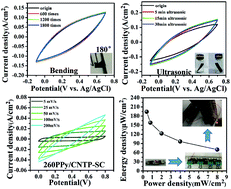Ultra-high performance and flexible polypyrrole coated CNT paper electrodes for all-solid-state supercapacitors†
Abstract
Ultra-high performance, flexible, and good conductive polypyrrole (PPy) coated carbon nanotube paper (CNTP) electrodes are successfully prepared by a facile in situ interfacial polymerization method. The optimized PPy/CNTP electrode with a unique porous microstructure shows not only a prominent specific capacitance of 8604.5 mF cm−2 at 1 mA cm−2, but also an excellent electrochemical cycling stability of 107% capacitance retention after 12 000 cycles. Moreover, the prepared electrodes exhibit superior flexibility. These remarkable performances are attributed to the robust 3D nanoporous microstructure, high electrical conductivity of in situ polymerized PPy, and strong π–π interactions between the PPy and CNTP. An all-solid-state symmetric supercapacitor assembled with the optimized PPy/CNTP electrode exhibits a maximum specific capacitance of 2185.1 mF cm−2 at a current density of 1 mA cm−2, an outstanding energy density of 194.23 μW h cm−2 at a power density of 0.40 mW cm−2, and a superior power density of 7.99 mW cm−2 at an energy density of 70.13 μW h cm−2, further revealing great promise for supercapacitor application of the composite electrode.



 Please wait while we load your content...
Please wait while we load your content...